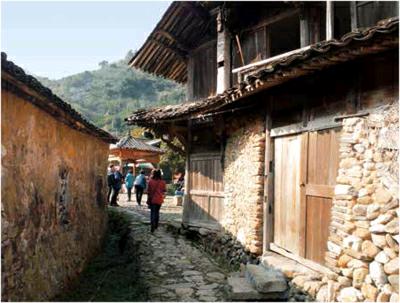碗窑:一份遗落山间的珍异
2017-10-17丁山
丁山
浙江温州苍南,玉苍山南坡玉龙湖河谷中上游处,有一个隐于茂密林木之中的小村落,层层叠叠的老房子依山而筑,大都为穿井式木石架构,称为吊脚楼,风貌古朴。300多年前,这里曾是民窑生产地,而且至今完整保留着古陶瓷生产线遗存。它便是碗窑村。
遺存仍在,可知当年碗窑盛景
碗窑村《巫氏宗谱》载,清康熙年间,福建连城巫氏因避战乱,迁居浙江苍南“蕉滩之东,素业陶瓷传家”。随后,其他姓氏也“实业瓷矿,屋宇连亘,人繁若市”,至乾隆年间达到极盛。
碗窑村以龙窑的方式烧制陶瓷品。龙窑又称阶级窑,它依一定的坡度建筑,斜卧似龙,在中国南方被广泛采用。由于此地的龙窑主要以烧制碗具为主——男子制作碗坯、烧窑成器,女人则为碗具画如意草或宝相花图案,“碗窑”的村名由此而来。
据说极盛时,碗窑村共有龙窑18条,吸引了40余姓聚居,4000人口中仅30余人务农,其余皆为窑主窑工。时光如梭,如今那18条龙窑,完整保留下来的仅有一条,为清康熙年间由王氏建造,现在仍可使用,是游客们前来参观的必到之处。这条龙窑有17级斜卧阶梯窑体,还有一座已成标志性建筑物的高大烟囱。远远望去,那塔状的烟囱矗立在一片溪畔民居之上,锥形的外观、灰黄的色调既敦实又古朴。
由于此地水资源丰富,自古以来,当地乡民建成多处水碓装置用于农事,后来主要制作粘土原料。这些水碓多数建于明代,如今其中的一套装置已经恢复。苍南玉龙湖碗窑旅游开发有限公司陈尔东经理告诉笔者,由这套水碓装置捣制的粘土原料,品质与古陶瓷用料并无二致。
游客来到这里,有的也会发出疑问:这里四面环山,似乎缺乏便捷的交通,巨量的陶瓷成品是怎么运出去的?事实上,以往的碗窑村依山傍水,一条自玉龙山发源的大溪就从村前流过,水量充沛,可以行船放排。这条大溪通鳌江,1958年建造桥墩水库后,才改变了走向。不过,流过村前的那段水道依然在,村里老人告诉笔者,大溪边古埠头那些被磨得又光又亮的枕头石,即是当年商贸物流旺盛的见证。
为何碗窑古村至今名闻遐迩?
以龙窑为烧制方式的古陶瓷产地,在浙江、福建、江西等地分布较广,遗存也不在少数,但为何碗窑村独独闻名遐迩?
这首先是因为碗窑村当年为浙南最大的古陶瓷产地,与普通民众日常生活的关系更为密切,影响及至现今。一名老窑工告诉笔者,旧时,碗分成细碗、粗碗,碗窑村生产的即为后者,它不大可能成为精致的工艺品,但能极大地满足生活所需,大圈碗、小圈碗、点心碗、酒盏醋碟、调羹汤盆等,花色品种丰富,装饰简单朴实,为普通百姓所深深喜爱。老窑工说,碗窑村旺发时,每月能卖掉162万只碗。盛况由此可见。
清代青花窑址保存丰富,是碗窑村受人关注的另一大原因。在这里,古陶瓷烧制作坊等原始设施,包括水碓、瓷土漂洗池、沉淀池及制坯工棚、窑床等遗址、遗物均较完整地保存着,不少以随地取材的木板制成的工具,也都有保留。而其产品的烧制、装饰等,都体现着鲜明的瓯窑特色。
碗窑村颇受当代人青睐,还有一个不可忽视的原因,是其简朴粗糙的材质和造型,与当今所倡导的原生态生活方式相一致。很多城市居民久居高楼大厦,渴望亲近大自然,而碗窑村采用原始烧制技术制作的粗瓷碗具,符合简朴生活方式和生态环保理念,成为人们争相收藏和使用的器具,前来碗窑村索取古陶瓷碗的人越来越多,这也在一定程度上推动了“碗窑热”。2013年,住建部、文化部、财政部联合公布“第一、二批列入中国传统村落”名单,碗窑村列入其中。这座古村不仅是重要的浙江古陶瓷业和非物质形态文化遗产的遗存点,而且已成为不可多得的乡村人文旅游景区。
不可错过的八角楼、古戏台和三官庙
当年碗窑村的产品颇受浙南和闽赣一带市场的好评,前来要货的客商很多,“很多客商为了囤积货源,干脆就住在这里等货,一住就是半年。所以,以前这里还开设了不少客栈,遗存至今的木结构八角楼,依稀可见古客栈的格局,很可能就是客商们的下榻处”,陈尔东介绍。
那座在江南古村极少见到的纯木结构八角楼,因地制宜地建成了五边形,后侧则另有三面墙体,与屋檐也呈八边,故被称为八角楼。八角楼共两层,形状复杂,全木质,由卯榫架构,未用一枚铁钉,且十分牢固,历经数百年风吹雨打,依然挺立于山坡路旁。游人来到八角楼下,抬头望去,二楼那个垂柱支撑的向外挑出的阳台,形制小巧,有一种不无浪漫的韵味。
为了挽留各方来客,清中叶,村里集资兴建了两座戏台,保留至今的那座是歇山顶木结构建筑,平面呈方形,外观呈亭台状。或许在村民心目中,它是祖宗留下的重要财产,保护得十分完好,屋脊上的仙人走兽都很完整,戏台顶面藻井上的彩画极其精致。南戏专家们曾认为,光是这些彩画,即可认定这座古戏台的文物价值。
古戏台对面有建于清初的三官庙,供奉道教天神天官、地官、水官。大殿上方有龙形图案,由大到小,旋形而上,最大直径约4米,如同大铜钟罩,俗称“田螺钻”。三官庙各殿有大大小小藻井13个,藻井内所描绘的人物、诗词、花草等,与古戏台彩画有异曲同工之妙。经考证,三官庙中的藻井彩画为当年流行的12部戏剧故事中的人物和场景,数百年后彩画依然画面清晰、色泽鲜艳。
能否重现碗窑制陶业昔时荣光?
碗窑村的老人回忆,碗窑村制陶业渐渐衰落的最后一个时间节点,应是在1936年。是年,村里不少人家无奈地将成品碗具垒放在家中,大多数龙窑也已熄火。新中国成立后,虽然有过重振碗窑村制陶业的努力,生产设备也有所改进,但盛景终究没有重现。
不再生产碗具的碗窑村,浪费了制作碗具的设备和技艺,当地村民也颇感可惜。直到这几年以古龙窑、古村落为重点,开发了旅游文化项目,部分村民获得了为游客表演古老制碗手艺的机会,旧时的景象稍有恢复。endprint
碗窯村党委书记许明进说,事实上,这里的碗具生产从未消亡,有经验的窑工还在村里。这几年,碗窑村的产品也有一定的销量,主要用于收藏。
然而,从另一角度理解,古法烧制陶瓷产品的弊处,何尝又不是优点?当龙窑窑体及各个装置、物件得以抢救性发掘之后,相信碗窑村的制陶业将会来一次嬗变。苍南县文联主席岳盛笑对笔者说,结合碗窑村大力发展文化旅游项目这一契机,引导游客投身制碗体验,在亲手制坯、烧制、上釉、添画的过程中,享受古法制陶之魅力,同时打响碗窑村原生态制碗品牌,定能为重现碗窑村旧时荣光提供一条可行路径。笔者已经看到,在碗窑村,由朱氏古居改建的碗窑博物馆和由村仓库改建的碗窑陶艺博物馆已经落成开放,古村修缮工程正如火如荼,数处游客体验点也已推出。碗窑村业态重振的探索之路已经起步。
(本文照片由作者提供)
Wanyao Village Makes Pottery Bowls
By Ding Shan
Wanyao is a village nestled in a wooded valley in Cangnan, a county under the jurisdiction of Wenzhou in southern Zhejiang. The village has houses perched on hillsides. Most of these houses are stilt ones. Over 300 years ago, the village was a major producer of pottery bowls fired in dragon kilns. “Wan” in the name Wanyao suggests bowls and “Yao” in the name points to kilns.
A family surnamed Wu migrated to the village in the early Qing (1644-1911) from Fujian to the south of Zhejiang province. The family started the pottery making in the village. As the family business flourished, other families joined the industry and settled down in the village.
According to history records, the village had 18 dragon kilns in its prime during the 60-year reign of Emperor Qianlong who ruled from 1736 to 1796. With a population of 4,000 of 40 plus clans, the village had only 30 villagers engaged in farming and the rest were all in the pottery making business. Now only one dragon kiln remains and still operates. It was built by the Wang family during the 1654-1722 reign of Emperor Kangxi. The 17-section dragon kiln stretches upward on a hillside. The tall chimney of the kiln serves as a landmark. The kiln attracts tourists from far and wide.
Before the pottery making business flourished, farming was the main business in the region. On a stream that flowed past the village were many water-powered trip-hammers. One water-powered hammer is now restored. When the village flourished in pottery making, these hammers were used to make clay, a key material for pottery making.
The village is now surrounded by mountains. Many might wonder how pottery products were shipped out to the outside in ancient times. There used to be a river passing by the village and emptied into Ao River. A reservoir was built nearby in 1958 and the stream changed its course, leaving the village stranded high on the hillsides. But the dried waterbed is still there and the rocks of the ancient docks still look smooth and shiny, serving as evidence of the flourishing trade of the yesteryears.endprint
Pottery making used to flourish in Zhejiang and neighboring Fujian to the south and Jiangxi to the west. Why is Wanyao village so special?
It is because the village was the biggest pottery maker in the south of Zhejiang. In the past, pottery bowls were classified into two categories: fine-pottery bowls and crude bowls. Wanyao Village made crud-pottery bowls: they were simple in style and the rich variety satisfied the needs of ordinary households. A retired potter at the village recalls that once upon a time the village sold off 1.62 million bowls a month.
Another huge attraction of Wanyao is that the village retains a somewhat relatively complete chain of a blue and white porcelain making system built in the Qing Dynasty (1644-1911). Many sites and workshops and devices are still around. You can see how the clay was made, how crude pottery pieces were made, how clay was purified.
In 2013, Wanyao was listed by the central government as a Traditional Village of China. The village is now a key legacy of ancient pottery making and intangible cultural heritage of Zhejiang province. Moreover, it is a tourism attraction for people to see how rural culture and industry looked like in the past.
In its heydays, Wanyao was more than a pottery producer. It was a regional trade center. According to local historians, some traders stayed in the village for half a year to build up a stock. The village catered to the traders and offered hospitality, as testified by the existing octagonal house, the village theater stage, and the Taoist temple. The octagonal house is a wood structure, a typical architectural style of the south of the Yangtze River Delta. It is actually a pentagon. It is called an octagon because the three walls on the back side form an octagon with the eaves. The two-story structure stands firm without using a single iron nail, even though it is hundreds of years old. In the middle part of the Qing, the village had two theater stages built to entertain guests from the outside world. Only one stands now. You need just a glance at the ornate decoration of the stage to know that it is a very rare cultural heritage. The Taoist temple is well preserved. In particular, the halls have 13 caisson ceilings with opera tales finely painted on them. The paintings still look vivid and in bright colors even though they are hundreds of years old.
Pottery making in the village stopped abruptly in 1936. The finished products were piled high at homes and the dragon kilns stopped working. After the founding of the Peoples Republic in 1949, an effort was made in vain to restore the pottery making tradition. As tourism booms, traditional bowls are seeing a modest comeback. Some old houses are refurbished for tourism. Visitors can try their hands at making pottery bowls. Whether pottery making as an industry can come back can only be answered by the future.endprint
